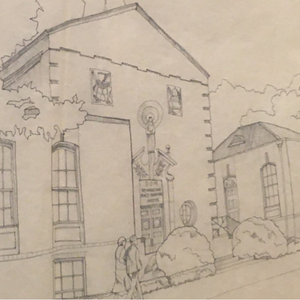 STM celebrates one-hundred years of Catholic chaplaincy at Yale University beginning this fall. This celebration includes a series of archival exhibits in Riggs Study throughout the year, focusing on STM's one-hundred years of Catholic ministry throughout the decades. Exhibits will be paired with a blog each month. Be sure to read along and come visit Riggs Study throughout the school year!
STM celebrates one-hundred years of Catholic chaplaincy at Yale University beginning this fall. This celebration includes a series of archival exhibits in Riggs Study throughout the year, focusing on STM's one-hundred years of Catholic ministry throughout the decades. Exhibits will be paired with a blog each month. Be sure to read along and come visit Riggs Study throughout the school year!
The 1930s saw Father T. Lawrason Riggs ꞌ10 beginning a capital campaign to build a Catholic Chapel on Yale’s campus. As he wrote in the fundraising material for the Chapel, it was to be a Catholic space “properly planned, attractively designed and conveniently located” and would “provide [students] with better facilities for attendance at daily mass, while at Sunday Mass…they would come into regular contact with the Chaplain, who would thus have a much more favorable opportunity to [spark] their interest in study groups, lectures and so forth.” The funds were acquired by the late 30s and the New York Times reported that the building of a club house and chapel were imminent with the headline “Catholics to Have Their Own Chapel” on November 18, 1936. Ground was broken on October 13, 1937 on Park Street, and the Chapel was finished the summer of 1938.
The Chapel was designed by William Douglas of William Douglas Orr & Associates and reflected the architectural tastes of the day. William Douglas was also known for designing the New Haven Lawn Club on 193 Whitney Avenue and its Colonial Revival similarities with STM’s Chapel are noticeable. Once completed, along with the Chapel’s Colonial Revival exterior, its interior was decorated in the Art Deco style—a balance between tradition and modernity. Through the equally weighted presence of these two styles, Fr. Riggs ꞌ10 hoped that Yale students would notice how their Catholic faith and their secular studies informed each other. This was also a way for this more physical Catholic presence at Yale to harmonize with the architecture of Davenport College and Pierson College across the street—and be a welcoming presence for Protestants.
The Chapel was finished in 1938 and dedicated on October 9th of that year. The original dedication date was September 25, 1938. This was postponed due to the highly destructive 1938 New England Hurricane. The October service was, according to Fr. Riggs ꞌ10, an “imposing ceremony.” It was presided over by Bishop Maurice F. McAuliffe and attended by members of both Yale University and the Archdiocese of Hartford. Fr. Riggs ꞌ10 also noted to his Board of Trustees that Bishop McAuliffe spoke briefly and “made a deep impression on the numerous non-Catholics present, as did the ceremony.”
The 1940s brought World War II and STM leadership began shifting their attention to war-time needs—like converting the Chapel’s boiler to meet war ration standards (burning coal rather than relying on oil). Fr. Riggs ꞌ10 continued to teach, offering religion courses each semester for both Yale students and the general public. Fr. Riggs ꞌ10 died unexpectedly of a heart attack in his home on April 26, 1943 and Father Edwin O’Brien ꞌ31, a product of Yale’s Catholic Club under Riggs in the late 20s, became Yale’s second Catholic Chaplain.
As Yale men went off to fight in the war, Yale opened its buildings to Army Air Force, Navy and Marine cadets stationed in New Haven for training. Because of this influx of servicemen, the Military Ordinariate appointed Fr. O’Brien ꞌ31 an Auxiliary Chaplain and the Chapel opened its doors to servicemen who would briefly call New Haven their home. In a Board report from the fall of 1943, Fr. O’Brien ꞌ31 mentioned that the chaplaincy had begun to hold dances for the cadets. And through the permission of the Bishop, the celebration of marriages in the Chapel would also begin—with the records of marriage being filed at the Military Ordinariate in New York and at St. Mary’s parish in New Haven.
During the war, Fr. O’Brien ꞌ31 also worked on the continued ornamentation of the Chapel—particularly its etched windows. Done through the artisans at Rambusch & Company of New York city, Fr. O’Brien ꞌ31 sought out donors to fund their work. The donors for the window project were a range of alums and current Yale parents—some of these Yale parents had lost their sons in the war and, through the windows, sought to remember their fallen children during their “bright college years.”
Come visit Riggs Study and learn what Catholic chaplaincy at Yale was like in 1930s and 1940s or view the exhibit online.
You can learn more about Fr. O'Brien from the QR code under his portrait in the Riggs Study or by viewing it online.
Works Referenced:
Alegi, Peter. “A History of Catholicism at Yale to 1943.” Department Essay in American Studies. Yale University, 1956.
Kelley, Mather. Yale: A History. Revised Edition. Yale University Press, 1999.
Riggs, T. Lawrason Riggs. "Chapel Fundraising Booklet." c. 1934.
Saint Thomas More Corporation. Board Meeting Minutes, 1938-1949.

 Sarah Woodford '10 M.Div.
Sarah Woodford '10 M.Div.


